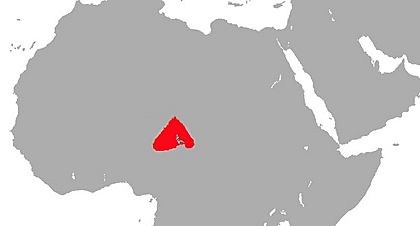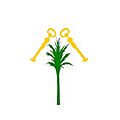Kanem–Bornu Empire facts for kids
Quick facts for kids
Kanem Empire
|
|||||||||||||
|---|---|---|---|---|---|---|---|---|---|---|---|---|---|
| c. 700–1380 | |||||||||||||
|
Flag of Kanem, also known as Organa, from Dulcerta atlas 1339
|
|||||||||||||

Influence of Kanem Empire around 1200 AD
|
|||||||||||||
| Capital | Njimi | ||||||||||||
| Common languages | Kanuri, Teda | ||||||||||||
| Religion | Animism, later Sunni Islam | ||||||||||||
| Government | Monarchy | ||||||||||||
| King (Mai) | |||||||||||||
|
• c. 700
|
Sef | ||||||||||||
|
• 1382–1387
|
Omar I | ||||||||||||
| Historical era | Middle Ages | ||||||||||||
|
• 700
|
c. 700 | ||||||||||||
|
• Invaded and forced to move, thus establishing new Bornu Empire
|
1380 | ||||||||||||
| Area | |||||||||||||
| 777,000 km2 (300,000 sq mi) | |||||||||||||
|
|||||||||||||
The Kanem–Bornu Empire was a powerful kingdom in Africa. It existed in areas that are now part of Niger, Cameroon, Chad, and Nigeria. It was known as the Kanem Empire from the 8th century AD. Later, it became the independent kingdom of Bornu (the Bornu Empire) and lasted until 1900.
The Kanem Empire (around 700–1380 AD) was located in modern-day Chad, Nigeria, and Libya. At its strongest, it covered most of Chad. It also included parts of southern Libya (Fezzan), eastern Niger, northeastern Nigeria, and northern Cameroon. The Bornu Empire (1380s–1893) was a state in what is now northeastern Nigeria. It grew even larger than Kanem, including parts of Chad, Niger, Sudan, and Cameroon.
We know about the empire's early history mostly from the Royal Chronicle, called the Girgam. A German traveler named Heinrich Barth found it in 1851. Today, parts of the empire still exist as traditional states within Nigeria. These are the Borno Emirate and Dikwa Emirate.
Contents
- History of the Kanem Empire
- How the Kanem Empire Began
- Founding by Local Kanembu People (Dugua Dynasty) around 700 AD
- The Duguwa or Dougouwa Dynasty (700–1086)
- The Sayfawa or Sefououwa Dynasty (1085–1846)
- Mai Dunama Dabbalemi: A Time of Great Expansion
- Moving the Capital: From Kanem to Bornu
- Mai Idris Alooma: A Golden Age
- Later Rulers and Decline
- The Fulani Jihad and New Leadership
- The Shehu of Borno
- Images for kids
- See also
History of the Kanem Empire
How the Kanem Empire Began
Kanem was located at the southern end of an important trans-Saharan trade route. This route connected Tripoli in the north to the Lake Chad region in the south. The area was home to different groups of people. Some were city dwellers, while others were nomadic (meaning they moved from place to place).
In the 8th century, writers started to describe the people living there. The name "Kanem" comes from a word meaning "south" in the local languages. As the Sahara desert became drier, people speaking the Kanembu language moved south to the Kanem area. These groups helped form the Kanuri people.
Founding by Local Kanembu People (Dugua Dynasty) around 700 AD
The exact start of Kanem is not fully clear. The first historical records suggest the kingdom of Kanem began around 700 AD. It was started by the nomadic Tebu-speaking Kanembu people. They were likely forced to move southwest towards the fertile lands around Lake Chad. This happened because of political pressure and the drying up of their old lands.
The area already had independent, walled city-states belonging to the Sao culture. The Kanembu, led by the Duguwa dynasty, eventually took control over the Sao. However, they also adopted many of the Sao's customs. Wars between the Kanembu and Sao continued until the late 16th century.
The Duguwa or Dougouwa Dynasty (700–1086)
Kanem was connected to Tripoli by a trade route through Bilma. Along this route, people who were captured were brought from the south.
Kanuri traditions say that Sayf b. Dhi Yazan started the rule of kings over the nomadic Magumi people. This was around the 9th or 10th century. For the next thousand years, the Mais (kings) ruled the Kanuri.
In 872, Al Yaqubi mentioned Kanem as one of three great empires in the region. He described the kingdom of the "Zaghāwa" people in a place called Kānim. This kingdom included several smaller kingdoms that paid tribute. Their homes were huts made of reeds, and they had no towns. Their cavalry (soldiers on horseback) gave them a military advantage. In the 10th century, al-Muhallabi mentioned two towns in the kingdom, one of which was Mānān. Their king was seen as divine, believed to have power over life and death. Wealth was measured in livestock like sheep, cattle, camels, and horses. From the 11th century onwards, the kingdom was called Kanem.
The Sayfawa or Sefououwa Dynasty (1085–1846)
The Kanuri-speaking Muslim Saifawas took control of Kanem from the Zaghawa nomads in the 9th century. This gave them control over the Zaghawa trade routes in the central Sahara, including the salt mines at Bilma. However, the main item traded was captured people. Tribes south of Lake Chad were raided, and the captured people were taken to Zwila in the Fezzan. There, they were traded for horses and weapons. The number of captured people traded each year grew from 1,000 in the 7th century to 5,000 in the 15th century.
Mai Hummay began his rule in 1075. He was the first Muslim king of Kanem. He became Muslim through his tutor, Muhammad b. Mānī. This new dynasty replaced the earlier Zaghawa dynasty. The Sayfawa remained nomadic until the 11th century, when they made Nijmi their permanent capital.
Mai Dunama Dabbalemi: A Time of Great Expansion
Kanem grew the most during the long and strong rule of Mai Dunama Dabbalemi (1210–1259). Dabbalemi started diplomatic talks with leaders in North Africa. He even sent a giraffe as a gift to the Hafsid monarch. He also helped set up a school (a madrasa) in Cairo to help people make pilgrimages to Mecca.
During his rule, he declared a jihad (holy war) against the tribes around his empire. He started a long period of conquest with his army of 41,000 horsemen. He fought the Bulala people for seven years, seven months, and seven days. After taking control of the Fezzan region, he appointed a governor there. He also gave military commands to his sons. As the Sayfawa expanded their control, military leaders were given special areas of land called cima.
Moving the Capital: From Kanem to Bornu
|
Bornu Empire
|
|||||||||||||||
|---|---|---|---|---|---|---|---|---|---|---|---|---|---|---|---|
| 1380s–1893 | |||||||||||||||
|
Flag of Bornu, also known as Organa, from Vallseca atlas of 1439
|
|||||||||||||||

Bornu Empire extent c.1750
|
|||||||||||||||
| Capital | Ngazargamu | ||||||||||||||
| Common languages | Kanuri | ||||||||||||||
| Religion | Islam | ||||||||||||||
| Government | Monarchy | ||||||||||||||
| King (Mai) | |||||||||||||||
|
• 1381–1382
|
Said of Bornu | ||||||||||||||
| Historical era | Middle Ages | ||||||||||||||
|
• Established
|
1380s | ||||||||||||||
|
• Disestablished
|
1893 | ||||||||||||||
| Area | |||||||||||||||
| 1800 | 50,000 km2 (19,000 sq mi) | ||||||||||||||
| 1892 | 129,499 km2 (50,000 sq mi) | ||||||||||||||
| Population | |||||||||||||||
|
• 1892
|
5,000,000 | ||||||||||||||
|
|||||||||||||||
| Today part of | |||||||||||||||
By the end of the 14th century, the Kanem Empire faced many problems. There were internal fights and attacks from outside. Wars with the Sao and the Bulala people led to the deaths of several Mais. Finally, around 1387, the Bulala forced Mai Umar b. Idris to leave Njimi, the capital. The Kanembu people moved to Bornu, which was on the western side of Lake Chad.
Even in Bornu, the Sayfawa dynasty continued to struggle. In the first 75 years of the 15th century, fifteen different Mais ruled. Then, around 1460, Ali Gazi (1473–1507) defeated his rivals and began to strengthen Bornu. He built a strong capital city called Ngazargamu, west of Lake Chad (in modern-day Nigeria). This was the first permanent home for a Sayfawa mai in a century.
The Sayfawa dynasty became so strong again that by the early 16th century, Mai Idris Katakarmabe (1507–1529) was able to defeat the Bulala. He even recaptured Njimi, the old capital. However, the empire's leaders stayed in Ngazargamu. This was because the land there was better for farming and raising cattle. Ali Gaji was the first ruler of the empire to use the title of Caliph.
Mai Idris Alooma: A Golden Age
Bornu reached its peak during the rule of Mai Idris Alooma (around 1564–1596). The empire grew to its largest size, taking control of Hausaland and the lands of the Ahir and Tuareg people. He made peace with the Bulala, agreeing on borders and a promise not to attack each other.
Idris Alooma brought new military ideas. He used soldiers on horseback with Turkish muskets, and also soldiers who were captured and trained to use muskets. His army also had armored cavalrymen and foot soldiers. They used clever military engineering, like during the siege of the town of Amsaka. His army was well-organized, with an advance guard and a rear reserve. They often used shield wall tactics. The Bornu army traveled by camel or large boats. Free women and captured women cooked for the soldiers. They sometimes used a "scorched earth" policy, burning everything in their path, to conquer fortified towns.
New forts (called ribāts) were built on the borders. Trade routes to the north became safe. This allowed Bornu to have good relations with the Pasha of Tripoli and the Turkish empire. Between 1574 and 1583, the Bornu sultan had diplomatic talks with the Ottoman sultan Murad III and the Moroccan sultan Ahmad al-Mansur. Bornu even allied with Morocco against the Ottoman Empire in the Sahara. Ibn Furtu called Alooma Amir al-Mu'minin (Commander of the Faithful). He put Islamic law (Sharia) into practice. He also relied on large landowners to make sure justice was served.
The trade route from Lake Chad to Tripoli became very busy in the 17th century. Horses were traded for captured people. There was a lot of diplomatic activity between Bornu and Tripoli at that time. About two million captured people traveled this route to be traded in Tripoli, which was a major market. It is said that "Wells along the way were surrounded by the skeletons of thousands of slaves, mostly young women and girls, making a last desperate effort to reach water before dying of exhaustion once there."
Later Rulers and Decline
Most of Idris Alooma's successors are only known from brief records. Some of them are remembered for making the pilgrimage to Mecca, others for their religious devotion. In the 18th century, Bornu suffered from several long periods of famine.
The strong government and military ideas of Idris Alooma helped the empire last until the mid-17th century. After that, its power began to weaken. By the late 18th century, Bornu's rule only reached westward, into the land of the Hausa people in modern Nigeria. The empire was still led by the Mai, who was advised by his councilors (kokenawa) in the state council (nokena). This council included his sons, daughters, other royal family members, and non-royal people. The non-royal members included free men and captured men who were eunuchs (called kachela). These kachela became very important in Bornu politics.
During the 17th and 18th centuries, Bornu became a center for Islamic learning. The Bornu sultans gained political power based on their religious authority. Islam and the Kanuri language became widely used. The economy was boosted by raiding for captured people.
The Fulani Jihad and New Leadership
Around this time, Fulani people from the west began to invade Bornu during the Fulani War. By the early 19th century, Kanem–Bornu was clearly losing its power. In 1808, Fulani warriors conquered Ngazargamu. Usman dan Fodio led the Fulani attack. He declared a jihad (holy war) against the Muslims in the area whom he believed were not religious enough. His campaign affected Kanem–Bornu and encouraged a return to strict Islamic practices.
Muhammad al-Amin al-Kanemi challenged the Fulani advance. Kanemi was a Muslim scholar and a military leader who was not from the Sayfawa family. He brought together different groups of people, including Shuwa Arabs, Kanembu, and other nomadic peoples. In 1814, he built a new capital at Kukawa (in modern-day Nigeria). The Sayfawa mais remained kings in name only until 1846. In that year, the last mai started a civil war with the help of the Ouaddai Empire. This led to the death of Mai Ibrahim, the last mai. At that point, Kanemi's son, Umar, became the Shehu (a new title for the ruler). This ended one of the longest ruling families in history. By then, Hausaland in the west was lost to the Sokoto Caliphate. The eastern and northern parts were lost to the Wadai Empire.
The Shehu of Borno

Even though the Sayfawa dynasty ended, the kingdom of Kanem–Bornu continued to exist. Umar, the new ruler, used the title shehu instead of mai. He was not as strong a leader as his father. He gradually allowed his advisors (wazirs) to rule the kingdom. Bornu began to decline further because of problems with its government, local differences, and attacks from the powerful Waddai Empire to the east. The decline continued under Umar's sons.
In 1893, Rabih az-Zubayr led an invading army from eastern Sudan and conquered Bornu. After he was expelled shortly after, the state became part of the new Northern Nigeria Protectorate. This was under the control of the British Empire. Eventually, it became part of the independent country of Nigeria. When the British arrived, a part of the old kingdom was allowed to continue to exist. It is still there today, under the Nigerian government, as the Borno Emirate.
Rabih's invasion led to the deaths of Shehu Ashimi, Shehu Kyari, and Shehu Sanda Wuduroma between 1893 and 1894. The British recognized Rabih as the 'Sultan of Borno' until the French killed him on April 22, 1900, during the Battle of Kousséri. The French then took over Dikwa, Rabih's capital, in April 1902, after the British had taken Borno in March. However, based on their 1893 agreement, most of Borno remained under British control. The Germans occupied eastern Borno, including Dikwa, calling it 'Deutsch-Bornu'.
The French named Abubakar, the Shehu of Dikwa Emirate, as ruler. But the British convinced him to become the Shehu of the Borno Emirate instead. The French then named his brother, Sanda, as Shehu of Dikwa. Shehu Garbai created a new capital, Yerwa, on January 9, 1907. After World War I, Deutsch-Bornu became the British Northern Cameroons. When Shehu Abubakar died in 1922, Sanda Kura became Shehu of Borno. Then, when he died in 1937, his cousin, Shehu of Dikwa Sanda Kyarimi, became Shehu of Borno. This meant that Sanda Kyarimi reunited the territory that had been divided since 1902. In 1961, the Northern Cameroons voted to join Nigeria, effectively joining the borders of the kingdom of Bornu.
Images for kids
See also
 In Spanish: Imperio Kanem-Bornu para niños
In Spanish: Imperio Kanem-Bornu para niños










